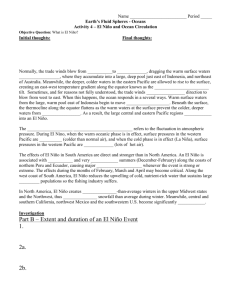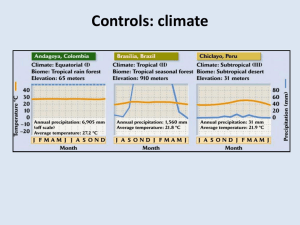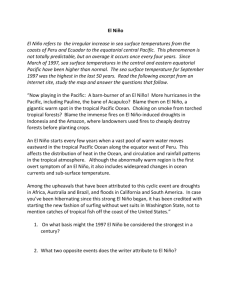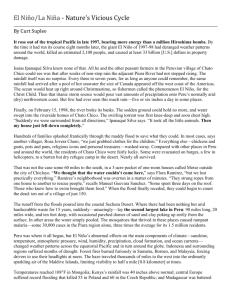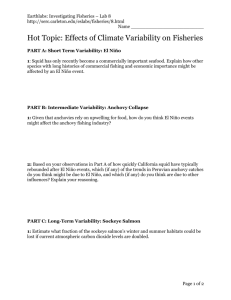The Rimrock Report
advertisement
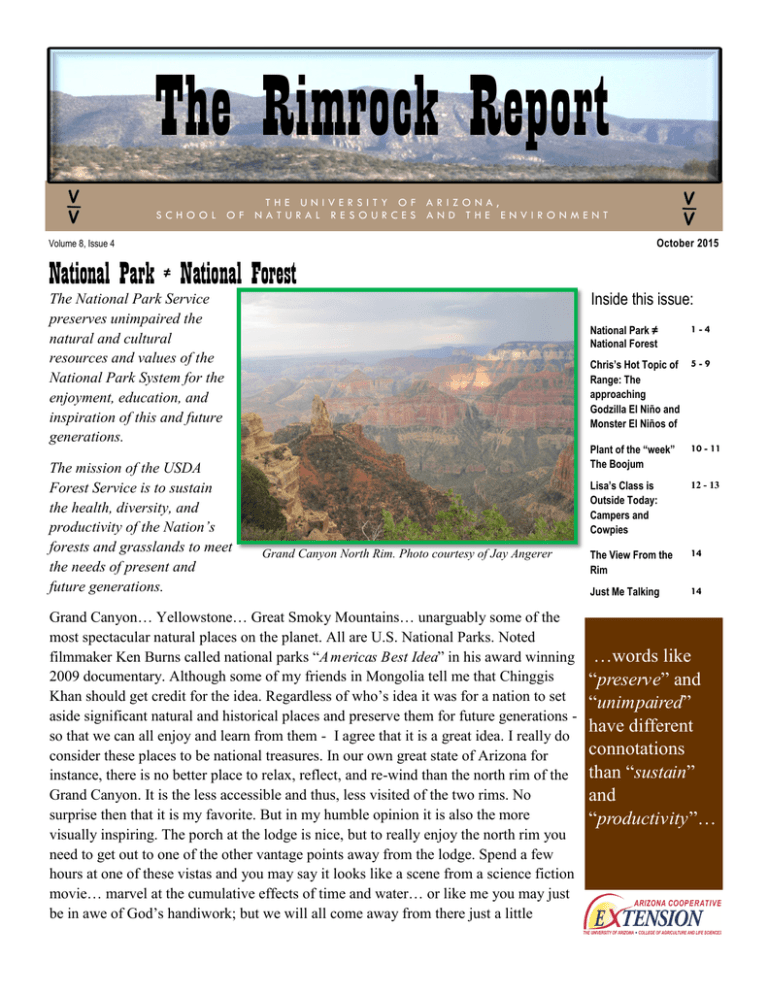
The Rimrock Report THE UNIVERSITY OF ARIZONA, SCHOOL OF NATURAL RESOURCES AND THE ENVIRONMENT October 2015 Volume 8, Issue 4 National Park ≠ National Forest The National Park Service preserves unimpaired the natural and cultural resources and values of the National Park System for the enjoyment, education, and inspiration of this and future generations. The mission of the USDA Forest Service is to sustain the health, diversity, and productivity of the Nation’s forests and grasslands to meet the needs of present and future generations. Inside this issue: National Park ≠ National Forest 1-4 Chris’s Hot Topic of 5 - 9 Range: The approaching Godzilla El Niño and Monster El Niños of Grand Canyon North Rim. Photo courtesy of Jay Angerer Grand Canyon… Yellowstone… Great Smoky Mountains… unarguably some of the most spectacular natural places on the planet. All are U.S. National Parks. Noted filmmaker Ken Burns called national parks “A mericas Best Idea” in his award winning 2009 documentary. Although some of my friends in Mongolia tell me that Chinggis Khan should get credit for the idea. Regardless of who’s idea it was for a nation to set aside significant natural and historical places and preserve them for future generations so that we can all enjoy and learn from them - I agree that it is a great idea. I really do consider these places to be national treasures. In our own great state of Arizona for instance, there is no better place to relax, reflect, and re-wind than the north rim of the Grand Canyon. It is the less accessible and thus, less visited of the two rims. No surprise then that it is my favorite. But in my humble opinion it is also the more visually inspiring. The porch at the lodge is nice, but to really enjoy the north rim you need to get out to one of the other vantage points away from the lodge. Spend a few hours at one of these vistas and you may say it looks like a scene from a science fiction movie… marvel at the cumulative effects of time and water… or like me you may just be in awe of God’s handiwork; but we will all come away from there just a little Plant of the “week” The Boojum 10 - 11 Lisa’s Class is Outside Today: Campers and Cowpies 12 - 13 The View From the Rim 14 Just Me Talking 14 …words like “preserve” and “unimpaired” have different connotations than “sustain” and “productivity”… The Rimrock Report Page 2 National Park ≠ National Forest….continued different. That is one of the cool things about national parks. Cliché as it may sound, we can all feel like the parks belong to us and that we can have our own personal experiences there. Even if we paid to get in and are surrounded by thousands of our closest friends. I will never forget going to Grand Canyon for the first time with my Mom, Dad, and little Sister when I was about 8 years old. I don’t remember the other people there, just us… looking at the biggest hole in the ground I had ever seen, the wild array of colors, and my folks laughing at me chasing those funny little squirrels with the big ears around our campsite. Somewhere, stuck in a family scrapbook, there are faded Polaroids to prove it. Verde River and Mingus Mountain in winter Those of you under the age of 40 will probably have to Google “Polaroid Camera” to know what I am talking about. To me, these little personal or family moments are one of the gifts of national parks. They are priceless. So what about national forests? Why did I choose the title of this article? Don’t national forests have spectacular scenery and historical sites? Can’t we have similar experiences in them? Yes, many of them absolutely do, and yes, we certainly can. I think national forests are also national treasures. I could (but I will spare you) recount similar family camping trips to the Ouachita, Sam Houston, or Mark Twain national forests when I was a kid. National forests provide many outstanding recreational opportunities for millions of visitors each year and most of the time there is no entrance fee. But they are not parks. Did you catch any differences in the two mission statements at the beginning of this article? Both are concerned with providing opportunities for future generations, but words like “preserve” and “unimpaired” have different connotations than “sustain” and “productivity”. A national park is not the same as a national forest. Nor should they be. They each have specific important purposes and should be managed differently. Upper West Clear Creek By now I expect those of you employed in agriculture or natural resources are probably either asking yourselves why I chose to write about something so obvious or, are saying “yes, somebody needs to talk about this”. The reason I chose to write about this subject is that I live and work in one of the most spectacularly beautiful places in the world, and although we do have some great national monuments and historic sites in our area, we are not a Page 3 Volume 8, Issue 4 National Park ≠ National Forest….continued national park. Most of the land in the Verde Valley is within either the Coconino or Prescott national forests. It does not get much prettier than snow on the red rocks of Sedona, sunsets over Mingus Mountain after a monsoon thunderstorm, or golden eagles soaring along the sheer cliffs in West Clear Creek. None of these places are national parks, but you may be surprised how many people I run across who don’t seem to know the difference. For them, the Verde Valley is their playground. On the one hand that is a great thing. People need to get out of Phoenix, away from traffic and noise, V Bar V cows in the pines near Mahan Park get out on the desert, range, and forest lands; to enjoy and appreciate the natural resources we have here. Our little communities need them to visit and spend money. But we also need them to understand that people live and work here. Not just in the local businesses, but out on the land. On their playground. We need them to understand multiple use. The U.S. Forest Service motto is: Caring for the Land and Serving People. Their website says that this phrase “captures the Forest Service mission. A s set forth in law, the mission is to achieve quality land management under the sustainable multiple-use management concept to meet the diverse needs of people” . There are a lot more people in the Phoenix (~3.5 million) and Tucson (~ 1 million) metro areas than there are in rural Arizona. The population of the entire state is ~ 6.5 million. And even though people in Arizona are generally pretty environmentally conscious, and grew up learning about the 5 C’s (Cattle, Copper, Citrus, Cotton and Climate) in school, it is still not too surprising that many view the lands outside of town as simply a place for recreation. Multiple use to them means that they can hunt, fish, hike, camp, bird watch, take photographs, ride ATV’s, etc… but they may not consider activities such as grazing or logging to be appropriate on public land such as a national forest. They tend to think of these places more like they do national parks. And I understand that. It is not really their fault. Most people in the U.S. are a generation or two removed from any type of agriculture or natural resource based livelihood. I have had people (local and tourists) ask me things like: “what are those fences doing on the forest anyway?”, “I pay taxes, this is my land, why do I have to shut gates?”, “ why do they allow cows on our forests?” or “why are they letting all those beautiful trees just burn V Bar V cow in Cedar Flat with view of red rocks up?” . The Rimrock Report Page 4 National Park ≠ National Forest.…continued Now to be honest, I have also had people ask me where they can go out on the national forest and see cowboys. But in general, the above described mentality and lack of understanding makes it tough for national forest managers who are trying to accomplish multiple use. It makes it tough for ranchers who are trying to turn renewable natural resources into a usable product for the public in a sustainable manner. It makes it tough for scientists and educators to obtain funding so that we can do research and provide education to help the land management agencies or producers do what they do. But that is just how it is. So, those of us who do live and work out here in the “middle of nowhere” have our work cut out for us. I am admittedly biased but I think this is especially true for those of us in extension. It is our job to not only help create knowledge and experience, but also to get the word out to the general public about our agricultural and natural lands. What they are, what they do, why they are important, how we should be stewards of them… So, I will apologize for this article being a little more rant and a little less educational, but this just hits close to home. I had intended to take a more thorough and scientific look at this subject but just ran out of time. I do have some interesting literature about the ecological condition of park lands in Canada. Maybe that can be a future article? While I am at it, I will also make this a recruiting call. Next time you are out on national forest land (or BLM for that matter), and you meet someone who thinks they are in a park… take some time and explain the difference. Brag about our national parks and our national forests. Tell them about the people who live in, work on, and care for these lands and manage them for the benefit of all of us. You might also tell them that if they would take their beer cans, diapers, and empty rifle shells back to civilization with them, we would sure appreciate it. Article by Doug Tolleson Bell Rock in the snow Page 5 Volume 8, Issue 4 Chris's Hot Topic of Range: The Approaching Godzilla El Niño and Monster El Niños of the past ‘Godzilla’ El Nino May Be on the Way ~ ABC news, 08-14-2015 Godzilla El Nino vs. the blob: ‘The mighty Godzilla will prevail’ ~ KOMO news, 09-02-2015 El Niño 2015-16: Godzilla or Mothra? ~ Dr. Mike Crimmins, WRRC Seminar 09-15-2015 The latest winter forecasts have been made and it seems we are in for a bit of a monster mash; a “Godzilla El Niño”! This El Niño is on track to be one of the largest ever recorded in the National Oceanic and Atmospheric Administration’s (NOAA) 65 years of tracking them; possibly beating out the previous record set back in the winter of 97-98. Godzilla is the king of monsters, and using him as the surname of El Niño brings to mind unrelenting widespread devastation and destruction. However, Godzilla has at times come to the defense of mankind, especially when faced with external threats such as invasions from Nebula M Space Hunter Aliens and their monster Gigan. So is this Godzilla El Niño friend or foe? What can we expect? What exactly is an El Niño anyway? In general an El Niño is defined as the warm phase of the El Niño Southern Oscillation (ENSO) and is described as a prolonged warming of ocean Figure 1: Scene from "Godzilla 2000" surface temperature along the equator in the Pacific Ocean. The specific quantitative definition is a little more complicated. There’s a stretch of Pacific Ocean some few hundred miles south of Hawaii called the Niño 3.4 Region (figure 2). NOAA records that area’s surface temperature and compares it to the average. If the water temperature is at least 0.5°C (0.9°F) above average for three consecutive months then we are in an El Niño, if the average is below 0.5°C (0.9°F) then we are in a La Niña phase. The strength of the El Niño or La Niña is determined by the current temperature’s distance from the average. The ENSO is not a perfect Oscillation, with the warming and cooling phases having no real pattern beyond periodically changing from warm to cool at two to seven year intervals, and each El Niño and La Niña event can last nine months to two years (Fig 3). No one knows exactly how the warming phase actually starts, but it seems the ENSO shifts between warm and cool with a third of the time in El Niño. At the moment we are 1.2°C (2.1°F) above average, and are projected to get warmer through the winter. Figure 2: Top: ENSO area where the Sea Surface Temperature (SST) is recorded to determine if we are in an El Niño. Bottom: Map of SST as of 9-28-2015 (earth.nullschool.net) The Rimrock Report Page 6 Chris's Hot Topic of Range… continued Figure 3: Top: Oceanic Niño estimates for El Niño/La Niña Oscillations since 1950. Bottom: Southern Oscillation Index of El Niño/ La Niña since 1880. Both graphs have the vertical axis in Celsius with above zero representing El Niño and below zero representing La Nina. So what can we expect from Godzilla? Globally there’s a reduction or even a reversal of trade wind speed along the equator in the Pacific. Ocean currents also change, reducing the amount of cool nutrient rich water that cycles up along the South America coast, which can devastate the fishing industry down there. For climate the general theme is more hurricanes in the Pacific, fewer hurricanes in the Atlantic, and drier and warmer conditions for the Pacific Northwest USA, South American tropics, Australia, and Southeast Asian tropics. For us in the Southwest USA we can expect cooler temperatures with above average moisture (Figure 4). The magnitude of all these changes often depend on the strength of the El Niño, and with a Godzilla El Niño…well now, we should expect a very interesting winter. Page 7 Volume 8, Issue 4 Chris's Hot Topic of Range…...continued The winter ‘should’ be interesting, which means it might; these are predictions after all. The 97-98 El Niño came in with a lot of fanfare as the largest recorded El Niño, with newsies shouting out calamitous climate predictions from newsstands across America. Newspapers ran headlines like, “Devastating El Nino Forecast/ Scientists fear ecosystem chaos”, the Federal Emergency Management Agency (FEMA) warned the population to prepare for potentially heavy rains and flooding, and several sources reminded the population that the previous monster El Niño in 82-83 killed 161 and cost $2.2 billion (1983 dollars). In Arizona the Bar T Bar Ranch, located east of Flagstaff, prepared for the 9798 monster El Niño by purchasing blizzard insurance for the first time. When the monster El Niño came it pummeled California with record rain and flooding, soaked Tucson with above average rainfall, and left the Bar T Bar with a below average mild winter (Fig 5). Figure 5: West Wide drought tracker. Rainfall from OctoberMay 1998 is compared to the average rainfall recorded over the past century. Northeast Arizona had average rain despite the Monster El Niño Graphs of the 97-98 cumulative winter rainfall for Tucson and Flagstaff show Tucson with above average rainfall by December while Flagstaff stayed below average until some late March storms finally brought the area some much needed precipitation (Fig 6) Figure 6: Cumulative winter rain charts from October to June with the brown area representing below average and green area representing above average precipitation. The bottom blue bars represent rainfall intensities. Left: Precipitation for the 97-98 El Niño for Tucson. Right: Precipitation for the 97-98 El Niño for Flagstaff. The Rimrock Report Page 8 Chris's Hot Topic of Range….continued That was the biggest El Niño recorded and it didn’t quite bring Flagstaff 14 inches of precipitation. The 8283 monster El Niño had a very similar impact to the southwest. California received record rain and flooding, Tucson was soaked with conditions almost identical to 97-98, and Flagstaff? Flagstaff received over 20 inches of moisture (Fig 7). This is why climate predictions are difficult, the climate model probabilities can increase or decrease, but they are still probabilities; Better betting odds are nice, but it still doesn’t mean we’ll win when we place our bets. Figure 7: Left; Cumulative winter precipitation for the 82-83 El Niño for Tucson. Right; Cumulative winter precipitation for the 82-83 El Niño for Flagstaff. Figure 8: West Wide Drought tracker. Rainfall from October-May 1998 is compared to the average rainfall recorded over the past century. Left: 82-83 Monster El Niño. Right: 72-73 Monster El Niño Volume 8, Issue 4 Page 9 Chris's Hot Topic of Range….continued Still, the probabilities can help us prepare for the winter. Figure 5 and Figure 8 show the West Wide Drought Tracker for the winter precipitation of the last three monster El Niños; 72-73, 82-83, and 97-98. You can see that there is a general pattern for these El Niños across the Southwest, but you can also see the variability in rainfall patterns in where the record rain falls and where there’s drought. In fact 72-73 was the last El Niño that brought Arizona record rainfall, with Happy Jack ranger station in Coconino County recording 37.5 inches, well above its 15 inch average and setting the record as the wettest and coldest winter in its recorded history (Fig 9). Meanwhile much of California was average with no record rain. What does this say about this year’s Godzilla El Niño Figure 9: Cumulative winter precipitation for 72-73 El Niño at Happy Jack Ranger Station and how it will impact us? That is still hard to say. Despite the historic data of past El Niños and sophisticated climate models it is difficult to create an exact prediction, that is the reason all the climatologists give a vague “cooler and wetter than average” answer and leave it at that. The gist of it is that there’s no real way to know the exact impact, especially when talking about local conditions. ENSO has a lot of variation to it and there are about a dozen other ocean oscillations that can pull and tug at various global conditions; and that is not including strange anomalies like the warm blob currently out between Hawaii and California. However, those vague climatologist answers can be useful, with good betting odds that this year will be great for skiing across the Southwest, that California better brace itself for potential floods, that Northern Arizona might finally see a decent snow pack, and that Southern Arizona will have a very wet Winter. Here’s hoping Godzilla comes in as a friend this time around. Scene from the 1968 classic “Destroy all Monsters” The Rimrock Report Page 10 Plant of the “Week” by Amber Dalke “Ho, Ho, a Boojum, Definitely a Boojum!” An early southwestern naturalist, Godfrey Skyes, provided the common name for the Boojum tree. The story goes that a group of scientists from the Desert Laboratory was standing on an elevated area in Sonora and Godfrey looked through his telescope and suddenly exclaimed “Ho, ho, a boojum, definitely a boojum!” The name boojum comes from the Lewis Carroll’s poem “The Hunting of the Snark,” which describes boojums as mythical beings found in a desolate far-off region. Most of the information we know about the boojum tree habitat and ecology was described in the work of the late Dr. Robert Humphrey “The Boojum and Its Home.” In honor of Dr. Humphrey’s fascination with boojums and the republishing of Photo credit: Harlow Gardens Plant of the Week his classic 1953 article “The Desert Grassland, Past And Present” in Fire Ecology (Volume 11, Issue 2, 2015), this newsletter will highlight the boojum tree (Fouquieria columnaris). The Boojum tree (also known as cirio, Spanish for candle) is a prehistoriclooking species native to the Baja California Peninsula of Mexico and two isolated populations on Isla Angel de la Guarda in the Gulf of California and a small area in Puerto Libertab in the state of Sonora. Long renowned for its attractive strangeness, boojum trees are an important species in social and economic contexts. They are considered a charismatic regional symbol, a horticultural curiosity, a decorative wood, and a local construction material. Cirio Near Las Tres Virgenes Volcano, Baja California (1966) by Eliot Porter Boojum trees resemble an upside-down light gray-yellow carrot. They have a thick, central trunk that is often over 10 m tall (and the largest recorded was >26 m tall). Boojums have a several centimeter thick pith and patches of soft, water-storing cells within the wood and bark, which can cause the trunk to be nearly three-quarters of a meter in diameter. The surface of the boojum trunk has a rock-like texture that appears to deter rodents from eating the juicy inner tissue. Their leaves are smaller than the closely related ocotillo (Fouquieriaceae family) and persist for months. Tubular creamy yellow flowers appear regularly in summer and fall and are typically pollinated by insects. The top of the boojum trunk or branching stems can arc and form loops into strange formations during its life span. Volume 8, Issue 4 Page 11 Plant of the “Week”...continued Living in an arid environment, boojums are well adapted to low rainfall. They generally get less than 120 mm of precipitation per year, but can survive 5 years or more without any rainfall. They grow very slowly, about 3-4 cm in a year with good rain. Growth occurs during cooler weather, when water is available. Boojums are often restricted to an area close to the coast, suggesting some relationship to a marineinfluenced climate. Relative humidity from moisture-bearing winds that are common year round in Baja likely aid in the survival, germination, and establishment of boojums. Boojums are long lived plants and may take 50 to 100 years from germination until the plant produces its first flower. It is common to find individuals that are older than 500 years old and some can live for over 700 years. Adolescent boojum on UA Campus While boojums are not a common rangeland plant in Arizona, they are a landmark of the Baja coast. They commonly grow in loose associations with other endemic plants of the Sonoran Desert, such as the elephant tree, datillilo (a tree-like yucca), and giant cardon cactus. The Dr. Seuss-like boojum tree can be seen at many places around the state including Boyce Thompson Arboretum State Park, Phoenix Botanical Gardens, and on the University of Arizona campus in the Joseph Wood Krutch Cactus Garden. Photo courtesy of the UA Campus Arboretum (1932) Boojums in front of the former Student Health building References Escoto-Rodriguez, M. and S.H. Bullock. 2002. Long-term growth rates of cirio (Fouquieria columnaris), a giant succulent of the Sonoran Desert in Baja California. Journal of Arid Environments 50: 593–61. Humphery R. R. 1974. The Boojum and its home. The University of Arizona Press, Tucson. Humphery R. R. 2001. Boojum. A tree grows in Baja. Wildflower 17: 20–22. Humphrey R.R. and D.B. Marx. 1980. Distribution of the Boojum Tree (Idria columnaris) on the Coast of Sonora, Mexico as Influenced by Climate. Desert Plants 2(3). The Rimrock Report Page 12 Lisa’s Class is Outside Today “Campers and Cow Pies” It’s interesting how Extension works – you typically end up meeting new contacts when you least expect it. Case in point: Chris and I attended the Diablo Trust land management group’s annual meeting earlier this spring to talk about our upcoming drought management workshops, and came away with a new opportunity for Range Rocks! collaboration. While at the meeting we were introduced to members of Friends of Camp Colton, an organization that supports Flagstaff Unified School District’s environmental education center. I saw this as a great opportunity to collaborate with a STEM based outdoor education program that would also help grow the Range Rocks! program in Northern Arizona. Up until now, we have been focusing on working with schools mainly in the Verde Valley area. This natural partnership providing range science activities to a STEM based outdoor education program also allowed us to focus on working primarily with a younger audience. As I have mentioned before, research is showing the benefits of providing hands-on learning opportunities to youth at a younger age. The Range Rocks! program originally began with a focus on high school programming, but as time goes on we are adapting to fit the shifting paradigm to incorporate range science lessons appropriate for a younger audience. Although we have provided Range Rocks! lessons to various age groups at Oak Creek School and NRCWAY and Hopi youth camps, working with Camp Colton would allow us to gain valuable experience working exclusively with 6th graders for six weeks. Friends of Camp Colton put me in contact with Mary Giannola, the new camp director at Camp Colton. Mary was interested in adding new content area to the camp’s existing outdoor educational programming. Enter Range Rocks! We shared with her the scope of the Range Rocks! program and invited her to visit our booth at the Arizona SciTech Festival so she could get a better understanding of the tools and technology we used and what we could add to her camp program. After visiting our booth, she agreed Range Rocks! would be a fantastic addition to the current Camp Colton programming. Sometimes the challenge is not finding new venues for a program, but finding people who can deliver the content area on the given dates. After looking at our busy fall schedules Doug, Chris and I realized we would need all hands on deck and in true extension fashion, we used this opportunity to collaborate with other Extension offices in the area for support. Dave Brewer, Program Coordinator at Coconino Extension, has over 30 years’ experience working with the Forest Service and the Ecological Restoration Institute. Elisabeth Alden, Assistant Agent from Mohave County and the Hualapai Tribal Extension has extensive experience working with youth and has worked at Camp Colton in the past. Both have been a tremendous help this season. Dave Brewer finds a tarantula and shows it to Our Range Rocks! program consisted of a 2 ½ hour instructional interested campers block in the morning, which was repeated in the afternoon for a new group of campers, which allowed all campers to take part in a Range Rocks! lesson that day. Campers rotated through three brief talks covering rangeland ecology, soils/soil profiles, and range animal nutrition. Range Science is unique in that its content area can be both very broad and very specific and also fits well into the STEM model currently being implemented in FUSD schools. We discovered each of our individual talks not only provided new knowledge, but also reviewed previous knowledge and concept ideas taught in FUSD Page 13 Volume 8, Issue 4 Lisa’s Class is Outside Today....continued science classrooms. Furthermore, we found our individual topic areas overlapped each other a bit, which helped to demonstrate how intertwined different range biology and systems are. Most campers were already familiar with several basic science concepts like photosynthesis, plant biology, soil composition and food webs. We built upon these core concepts and introduced new topics like range monitoring techniques, rangeland importance and uses, soil horizons and forest ecology, ruminant animal nutrition and the cutting-edge science behind cow patty composition. Yes, you read that correctly. One camper records ruminant After a short water bottle refill break digestion notes in his camp journal (its camp….DRINK MORE WATER!) the campers were given the rules to the Range Rocks! Scavenger Hunt. The campers were divided into small groups and given a set amount of time to find 12 numbered flags hidden throughout the camp property, each of which contained a question related to previous talks they had just heard. They discussed the question and answered it as a group and we are happy to report several groups answered all questions correctly! Not only did we assess student learning, we also allowed fidgety 6th graders to burn off some energy in the process – you have to love outdoor education! Working with Camp Colton was an incredible learning experience (for us as much as the campers, I’m sure) and we are looking forward to providing Range Rocks! programming at Camp Colton again in the spring when the camp reopens to welcome other schools in and around the Flagstaff area For the past six weeks our team has enjoyed being able to teach outside in the crisp autumn weather and seeing excited students fidgeting with small sticks and rocks yelling out “AAAAAYO” in response to a call for attention from camp staff. (Their enthusiasm often requires a bit of redirection from patient camp staff as it is the first time away from home for many campers.) The campers have impressed us with their excellent behavior, willingness to learn and entertaining random nuggets of information they feel compelled to share with the group that may or may not be related to the discussion topic. Either way, they kept us on our toes! A future artist draws a ruminant digestive system in his camp journal I’m sure each of us has felt that twinge of pride when a camper repeats something they have learned during one of our range science talks. I wish I could be a fly on the wall when the kids get home and mom and dad ask “so honey, what did you learn at camp?” If their answer has anything to do with describing the consistency of a high protein low fiber cow patty to them over dinner, I will know I did my job! A group answers a scavenger hunt clue The view from the Rim Teddy Roosevelt had a lot to say about western rangelands and the life they provide. Here are a couple of pertinent ones: "I do not believe there ever was any life more attractive to a vigorous young fellow than life on a cattle ranch in those days. It was a fine, healthy life, too; it taught a man self-reliance, hardihood, and the value of instant decision...I enjoyed the life to the full." "In the Grand Canyon, Arizona has a natural wonder which is in kind absolutely unparalleled throughout the rest of the world…. Leave it as it is. You cannot improve on it. The ages have been at work on it, and man can only mar it." The University of Arizona School of Natural Resources and the Environment V Bar V Ranch 2830 N. Commonwealth Drive Suite 103 Camp Verde, AZ 86322 Just me talking... Phone: 928-554-8991 Fax: 928-554-8996 Cell: 928-821-3222 E-mail: dougt@cals.arizona.edu Web: http://cals.arizona.edu/aes/vbarv/ Note: Please email me if you would like to be added to the “mailing” list for this newsletter. “On the road again, just can’t wait to get on the road again…” Me and ol’ Willie have been burning it up lately. You know you have been driving through Phoenix too much when you start to recognize vanity plates on I-10. I have had the same hotel room on several trips to Tucson and the waitresses at KG’s Westside Café on Grant have started calling me one of the regulars. Oh well. Between meetings, camps, workshops, trying to get an animal feeding study going and a lab set up, travel is just what is required. Just part of the glamorous extension lifestyle. Yes, we are now starting a sheep and goat diet chemistry:fecal spectra study at the Campus Ag Center in Tucson. This is an undergraduate honors thesis project for Sophie Leone. We will do a validation test of the existing Gan Lab small ruminant NIRS calibrations and evaluate the effectiveness of using domestic animals fed range diets, as surrogates for developing diet quality calibrations for wild animals. As you can see from Lisa’s article this issue, we spent a lot of time up at Camp Colton near Flagstaff with 6th graders in September. This was a great time and a new direction for Range Rocks! Many thanks to Elisabeth Alden (Mohave Co./Hualapai ext.) and Dave Brewer (Coconino Co. ext) for tag teaming with Chris, Lisa and myself. I am not sure who learned more, us or the kids. Jeff Schlau and I also participated in the third year of the Hopi Ranch Intern program a couple weeks ago. Thanks Pat Browning for putting that together. I think it is having an impact. The range crew helped out with fall cattle works on the V Bar V. Fall range monitoring is getting into gear. Chris will be out and about on several northern Arizona ranches in the next few weeks. We just started collecting the second year of range data on our Cedar Flat juniper treatment project this past week. UA Tierra Seca members Joey Dahms and Emilio Corella came up from Tucson and joined the V Bar V range crew, Sue Smith (grad student Utah State), Iric Burden (NRCS) and Steve Cassady (AZ G&F). Summer meeting for AZ SRM was good as usual, looking forward to Yuma in the winter. Dan Faulkner, Jim Sprinkle (before he left for Idaho…) and I hosted a group of ruminant nutritionists on the ranch back in August. We celebrated the 20th anniversary of the V Bar V as a UA facility at Ranch Explorer Day in August. It was great to have president Hart and CALS leadership (past and present) in attendance. I am heading to Brazil in a couple weeks to present a paper at the international NIRS conference, followed by a week in Texas to guest lecture at A&M and do a VGS workshop at Welder Wildlife Foundation with our own Del Despain, Lori Metz (NRCS) and Judith Dyess (USFS). Looking forward to the week after Thanksgiving and my first ever elk hunt in November. Well that’s about it. Christmas will be here before you know it. Till next time, Doug




